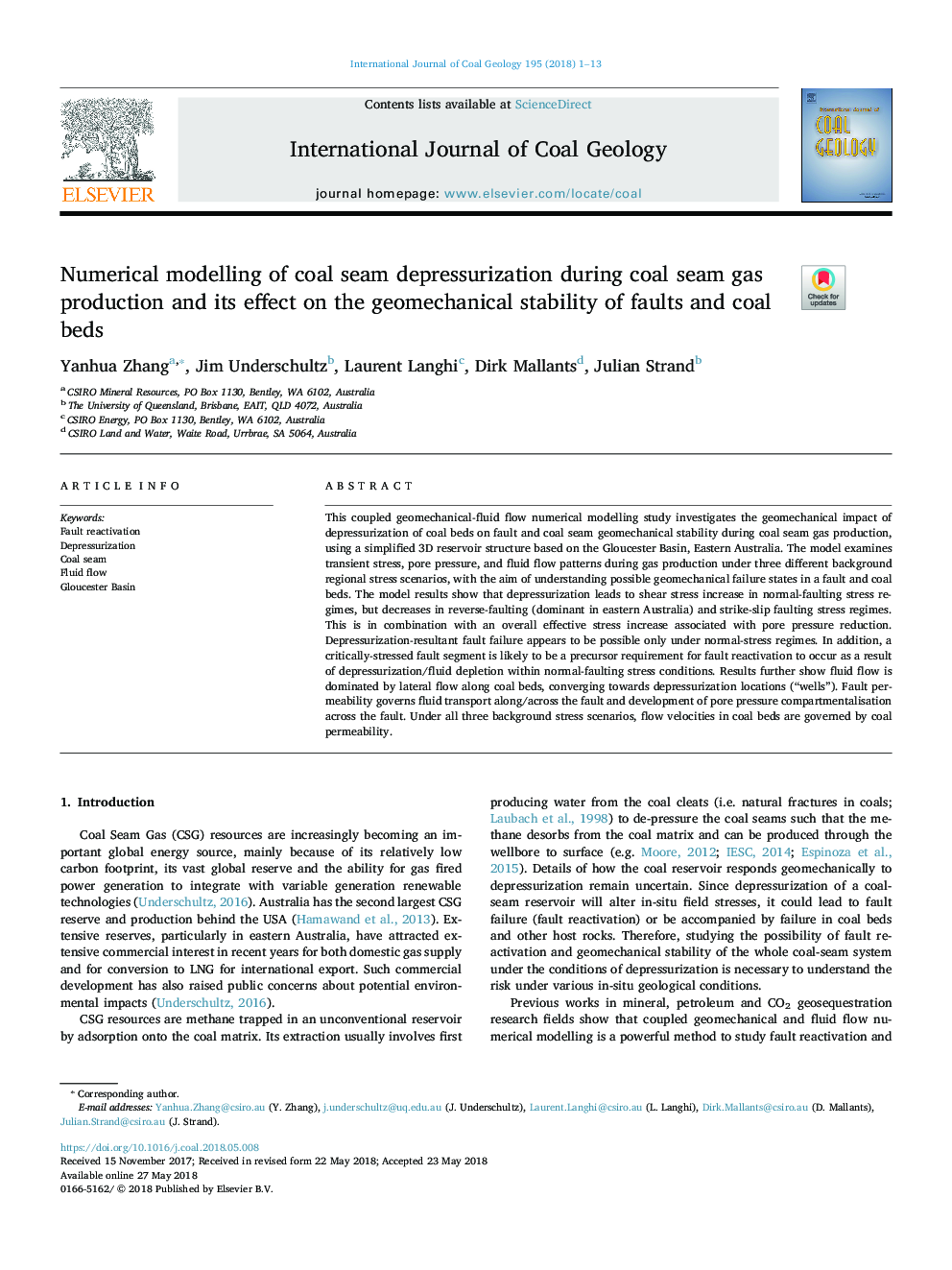| کد مقاله | کد نشریه | سال انتشار | مقاله انگلیسی | نسخه تمام متن |
|---|---|---|---|---|
| 8123295 | 1522508 | 2018 | 13 صفحه PDF | دانلود رایگان |
عنوان انگلیسی مقاله ISI
Numerical modelling of coal seam depressurization during coal seam gas production and its effect on the geomechanical stability of faults and coal beds
ترجمه فارسی عنوان
مدل سازی عددی از کاهش فشار جوشکاری زغال سنگ در طول تولید زغال سنگ زغال سنگ و تأثیر آن بر پایداری ژئومکانیکی گسل ها و فرورفتگی های زغال سنگ
دانلود مقاله + سفارش ترجمه
دانلود مقاله ISI انگلیسی
رایگان برای ایرانیان
کلمات کلیدی
دوباره فعال شدن گسل، کاهش فشار، جوش زغال سنگ، جریان سیالات، حوضه گلاستر،
ترجمه چکیده
این مطالعه مدلسازی عددی جریان جیوه جیوه جرمی مکانیکی با استفاده از یک ساختار مخزن سهبعدی ساده بر اساس حوضه گلاستر استرالیا، اثر استریم زیست محیطی بر میزان پایداری ژئومکانیکی دریچه گسل و زغال سنگ را در اثر کاهش فشار بر سطح زغال سنگ بررسی می کند. این مدل، تنش گذرا، فشار منفی و الگوهای جریان سیال را در طول تولید گاز در سه سناریوی استرس پس زمینه منطقه ای مورد بررسی قرار می دهد، با هدف درک شرایط احتمال شکست ژئومکانیکی در یک تونل گچی و زهکشی. نتایج مدل نشان می دهد که فشار کم فشار باعث افزایش استرس برشی در رژیم های تنش عادی می شود، اما کاهش خطای معکوس (غالب در شرق استرالیا) و ریسک های استرس گشتاور لغزش را کاهش می دهد. این در ترکیب با افزایش کلی مؤثر است که با کاهش فشار منفی همراه است. به نظر می رسد که تخریب خطای ناشی از کم شدن فشار تنها در شرایط رژیم عادی استرس وجود دارد. علاوه بر این، یک قطعه تقصیر به شدت تحت تأثیر قرار می گیرد، به عنوان یک پیشگویی مورد نیاز برای واکنش گسل در نتیجه کاهش فشار / تخلیه مایع در شرایط تنش عادی است. نتایج بیشتر نشان می دهد جریان سیال تحت تاثیر جریان جانبی در امتداد زوارهای زغال سنگ، همگرایی به سمت موقعیت های کم فشار (به خوبی؟). نفوذپذیری گسل حاکم بر حمل و نقل مایع در امتداد خطا و توسعه تقارن فشار منافذ در سراسر گسل است. در هر سه سناریوی استرس پس زمینه، سرعت جریان در تخت های زغال سنگ تحت تاثیر نفوذ پذیری ذغال سنگ قرار می گیرد.
موضوعات مرتبط
مهندسی و علوم پایه
علوم زمین و سیارات
زمین شناسی اقتصادی
چکیده انگلیسی
This coupled geomechanical-fluid flow numerical modelling study investigates the geomechanical impact of depressurization of coal beds on fault and coal seam geomechanical stability during coal seam gas production, using a simplified 3D reservoir structure based on the Gloucester Basin, Eastern Australia. The model examines transient stress, pore pressure, and fluid flow patterns during gas production under three different background regional stress scenarios, with the aim of understanding possible geomechanical failure states in a fault and coal beds. The model results show that depressurization leads to shear stress increase in normal-faulting stress regimes, but decreases in reverse-faulting (dominant in eastern Australia) and strike-slip faulting stress regimes. This is in combination with an overall effective stress increase associated with pore pressure reduction. Depressurization-resultant fault failure appears to be possible only under normal-stress regimes. In addition, a critically-stressed fault segment is likely to be a precursor requirement for fault reactivation to occur as a result of depressurization/fluid depletion within normal-faulting stress conditions. Results further show fluid flow is dominated by lateral flow along coal beds, converging towards depressurization locations (“wells”). Fault permeability governs fluid transport along/across the fault and development of pore pressure compartmentalisation across the fault. Under all three background stress scenarios, flow velocities in coal beds are governed by coal permeability.
ناشر
Database: Elsevier - ScienceDirect (ساینس دایرکت)
Journal: International Journal of Coal Geology - Volume 195, 1 July 2018, Pages 1-13
Journal: International Journal of Coal Geology - Volume 195, 1 July 2018, Pages 1-13
نویسندگان
Yanhua Zhang, Jim Underschultz, Laurent Langhi, Dirk Mallants, Julian Strand,
